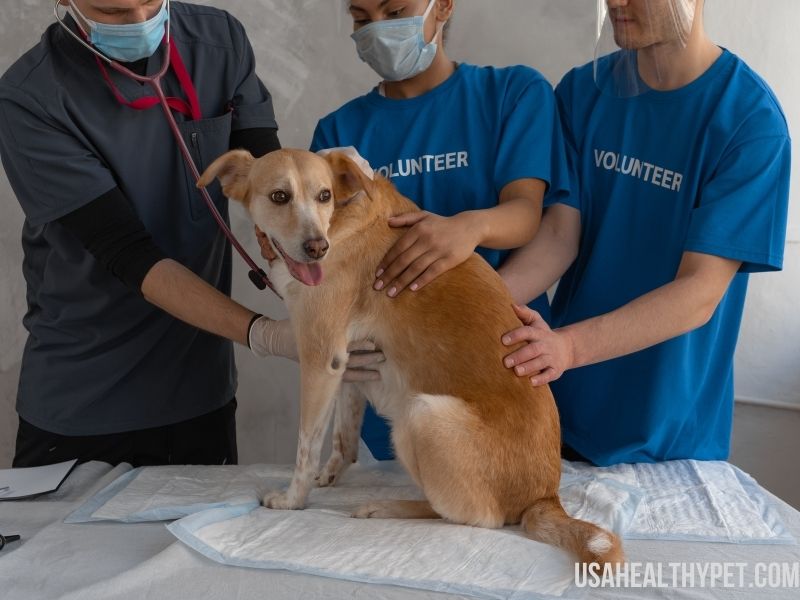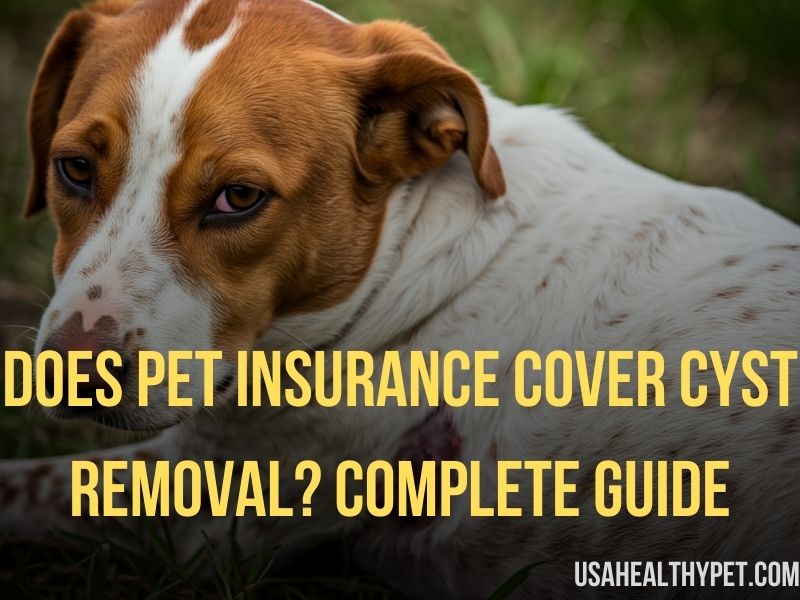Cyst Removal Coverage in Pet Insurance: Key Points
- Coverage Depends on Medical Necessity: Cyst removal may be covered by pet insurance if it’s considered necessary for your pet’s health.
- Accident and Illness Plans Are Ideal: Policies covering both accidents and illnesses are the most likely to include cyst removal.
- Costs Can Be High Without Insurance: Cyst removal can cost anywhere from $200 to over $1,000, depending on the procedure and complexity.
- Pre-existing Conditions Are Often Excluded: If the cyst was present before you got insurance, it might not be covered.
What Are Cysts, and Why Do They Occur in Pets?
Cysts are fluid-filled lumps or sacs that can appear on a pet’s skin or even internally. They’re often harmless but can become problematic if they grow, get infected, or start to irritate your pet.
For many pet owners, deciding to remove a cyst is more about the pet’s comfort than just aesthetics. After all, if a cyst grows large or painful, it can interfere with a pet’s daily activities and quality of life.
When faced with a cyst removal recommendation, the first question many pet owners have is whether their insurance will help cover the cost.
Let’s break down how pet insurance handles cysts, what types of policies are likely to cover removal, and other important details you should know.

Does Pet Insurance Typically Cover Cyst Removal?
Whether pet insurance covers cyst removal largely depends on the type of policy you have. For most insurers, coverage depends on whether the cyst removal is medically necessary.
In other words, if the cyst is causing pain, risking infection, or affecting your pet’s mobility, it’s likely to be covered. However, if the cyst is deemed purely cosmetic, coverage may not apply.
Pet insurance is usually divided into three types of plans:
- Accident-Only Plans: These cover injuries from accidents but generally don’t include illnesses, meaning cyst removal wouldn’t be covered.
- Accident and Illness Plans: These plans cover a wide range of treatments, including illness-related surgeries like cyst removal if they’re medically necessary.
- Wellness or Routine Care Plans: These plans focus on preventive care, like vaccinations and regular check-ups, rather than surgical procedures, so they usually don’t cover cyst removal.
If you’re considering pet insurance, accident and illness plans offer the broadest coverage and are the best choice for potential cyst removal coverage.
Factors That Affect Coverage for Cyst Removal
Each insurance company sets its own guidelines for what is and isn’t covered. Here are the main factors that can influence whether cyst removal is included in your policy:
- Medical Necessity: If the cyst is causing health issues—such as discomfort, pain, infection, or interference with your pet’s daily activities—many insurers will cover the removal.
- Pre-existing Conditions: If your pet had a cyst before you signed up for insurance or if it developed during the policy’s waiting period, the insurer may label it as a pre-existing condition, which likely won’t be covered.
- Policy Limits and Caps: Many policies set caps on coverage, which means they may only pay up to a certain amount for a procedure. Be sure to check if your policy has a limit for cyst removal surgeries.
- Pet’s Breed and Age: Some breeds are prone to skin conditions, and certain insurers may exclude or limit coverage based on breed. Additionally, older pets may face restrictions, as insurers can sometimes impose limitations on pets over a specific age.
Understanding these factors can help you avoid unexpected costs and give you peace of mind when planning for potential medical procedures.

Steps to Check Your Policy for Cyst Removal Coverage
It’s important to review your pet insurance policy carefully to understand what is covered. Here are some steps to take to ensure you know if cyst removal is included:
- Review Illness Coverage: Most policies will state whether illness treatments are covered. Look specifically for terms related to surgical procedures or illness care.
- Check for Medical Necessity Language: Some policies only cover treatments considered necessary for your pet’s health. This section may specify when procedures like cyst removal are covered.
- Clarify Exclusions: Most policies include a list of exclusions. Check if cyst removal or skin conditions are specifically mentioned as exclusions.
- Contact Your Provider: If you’re unsure about the language or have specific questions, reach out to your insurance provider. A quick call can clarify any confusion about cyst coverage.
Being informed about your policy’s specifics can help you avoid surprises if you’re faced with the need for cyst removal.
Pet Insurance Providers That Cover Cyst Removal
Some pet insurance providers are known for their comprehensive accident and illness plans, making them a reliable option for cyst removal coverage.
Here’s a closer look at a few popular providers and how they handle cyst-related claims:
- Embrace Pet Insurance
- Coverage: Embrace’s accident and illness plan includes cyst removal if it’s medically necessary.
- Pre-existing Conditions: Embrace excludes pre-existing conditions but may cover curable ones after a year of symptom-free status.
- Wellness Plan: While the wellness plan covers preventive care, it doesn’t cover surgical procedures like cyst removal.
- Healthy Paws Pet Insurance
- Coverage: Healthy Paws’ accident and illness plan generally covers cyst removal, provided it’s necessary for your pet’s health.
- Limitations: Healthy Paws doesn’t cover pre-existing conditions or treatments for cysts that develop during the waiting period.
- Trupanion Pet Insurance
- Coverage: Trupanion’s policies cover cyst removal as a medical procedure without per-condition limits, making it ideal for recurring issues.
- Exclusions: Trupanion doesn’t cover pre-existing conditions, so any cysts present before policy initiation won’t be included.
- Additional Benefits: Trupanion offers flexible deductibles but no wellness plans, so regular cyst checks would not be covered.
- Nationwide Pet Insurance
- Coverage: Nationwide covers cyst removal under their Whole Pet with Wellness policy if it’s medically necessary.
- Limitations: Their Major Medical policy may also cover cyst removal but has stricter reimbursement limitations.
- ASPCA Pet Health Insurance
- Coverage: ASPCA’s Complete Coverage plan includes medically necessary cyst removal procedures.
- Pre-existing Conditions: They cover curable pre-existing conditions after 180 days of symptom-free status.
These providers offer options tailored to different needs, and reviewing each company’s policies on illness and cyst coverage can help you select the right plan for your pet.

Costs of Cyst Removal Without Insurance
Cyst removal costs vary based on factors like cyst size, location, and the vet clinic’s fees. Generally, cyst removal can range from $200 to $1,000 or even higher for complex cases.
If lab tests, anesthesia, or follow-up visits are necessary, these additional charges can increase the overall expense.
Without insurance, you’ll be responsible for the full amount, which can be challenging depending on your budget.
For pet owners without insurance, deciding to remove a cyst may depend on whether the cyst is causing significant health issues or discomfort. If your pet’s quality of life is impacted, the procedure is often worth the expense.
Is Cyst Removal Worth the Cost Without Insurance?
When it comes to your pet’s health, most pet owners will do whatever it takes to ensure their comfort and well-being.
However, cyst removal costs can add up, especially if multiple procedures are required or if a cyst reappears over time.
While benign cysts may not be life-threatening, they can cause discomfort or become infected, which can lead to bigger health concerns.
For pet owners without insurance, paying for cyst removal out of pocket may feel like a significant expense, but it’s often worth it to prevent complications and keep your pet comfortable.
Tips for Choosing a Pet Insurance Policy That Covers Cyst Removal
Choosing a pet insurance policy with potential cyst coverage can help you avoid unexpected costs down the road. Here are some tips for finding the best plan:
- Opt for Accident and Illness Plans: These plans are more likely to cover cyst removal and provide the most comprehensive coverage.
- Review Pre-existing Condition Policies: Many insurers exclude pre-existing conditions, so it’s important to know whether past cysts will affect your coverage.
- Look for Flexible Deductibles and Claim Limits: Some policies allow you to adjust your deductible, which can help manage your monthly premium and out-of-pocket costs for treatments.
- Check Exclusions Carefully: Exclusions can vary significantly by provider, so be sure to confirm that cyst removal is not specifically excluded in the fine print.
- Ask About Medical Necessity Requirements: Some insurers only cover treatments deemed necessary for your pet’s health, so clarify what documentation is required for cyst coverage.
Making an informed decision about pet insurance can help protect both your pet’s health and your wallet when the need for medical treatment arises.
Conclusion: Protecting Your Pet’s Health with the Right Insurance
Cyst removal may seem like a minor procedure, but for your pet, it can make a world of difference.
If your pet’s cyst is causing discomfort, pain, or infection risks, insurance can help alleviate the cost and ensure that your pet gets the care they need without delay.
Understanding your policy and choosing the right insurance plan can help you be prepared for the unexpected and keep your pet healthy and happy.
By proactively exploring your insurance options, you can approach your pet’s health with confidence, knowing that you’re equipped to handle any medical needs that come your way.

Pingback: Does Pet Insurance Cover IVDD? Essential Guide
Pingback: Does Pet Insurance Cover Insulin for Diabetes?